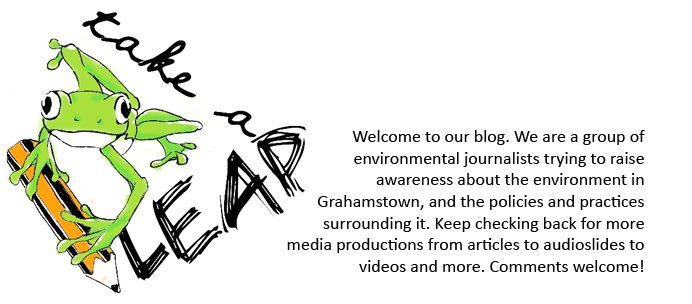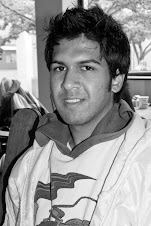I didn't think it would ever arrive, but here we are with only our final exhibtion and what I think is a very successful media campaign behind us.
Perhaps the highlights of our media production, for me at least, have been our attempts to engage with ideas of public journalism. Our graffiti-style banner encouraged people to personally voice their concerns about their local environment, in their own words, in their own style and I think the result was a very powerful collective community voice with very real community problems.
Our multimedia exhibition at the Egazini Community Centre, in Extension Six of Joza, was also a kind of public journalism, as we used our more visual media productions to stimulate debate around the issues of waste, water and sanitation. What followed was a very heated debate, again really allowing people to address their concerns on their own terms without a 'professional' journalist dictating the angle of the story. Our role was quite simply to stimulate and then provide a platform for much needed debate about the Municipality's shortcomings and successes. I think that this worked extremely well, particularly since it gave us useful footage to send to the municipality in order for them to be forced to be held accountable for their citizens.
Indeed, one of our most important aims throughout this campaign has been to avoid creating journalism in a vacuum and ensuring that our media production had some meaning outside of the AMM. It was for this reason that our WEPD group has worked hard to get our stories published in various local newspapers as well as distributing our very eye-catching educational posters and our eye-catching banner. In this regard, then, I think we have done well.
It is perhaps too soon to tell just how much of an impact our work will have. Our TV crew's PSA on illegal dumping has been accepted by the municipality to use for educational purposes, which is important for us, as a group who throughout our campaign have not only wanted to investigate the municipality's policy implementation, but also to work alongside them and help them to achieve their environmental objectives to some extent. Our educational posters have been placed around Grahamstown and hopefully, with time, they will at least educate a few people about LEAP and what it is all about. However, we do not assume that our media will have a 'magic bullet' or 'hypodermic needle' effect and magically revolutionise Grahamstown; it will take time and much more effort from those following us.
Our public journalism, however, I think has created an important spark in the Joza community. Not only did it get people thinking about what they weren't getting and what they deserved, it also generated discussion around individual initiatives to fix the problems which the municipality could not seem to get to. This was extremely rewarding for me. It seems as if our media has made some kind of difference - even if the municipality does not take notice (which, to be honest, they have been very prone to do in the past), at least we have encouraged people to pick up their own litter and create their own solutions to their problems.
I didn't think I would ever say it, after weeks spent chasing the ever-evasive municipality and endless hours of brainstorming, but I have really and thoroughly enjoyed being a part of Take A LEAP and creating media that didn't end up in the back of the lecturer's desk drawer and learning about different approaches to being a socially responsible journalist.
Take a LEAP. get to know your municipality and jump right into the work that we have done - I think it will be worth it.
Subscribe to:
Post Comments (Atom)





No comments:
Post a Comment